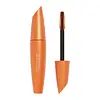What's inside
What's inside
 Key Ingredients
Key Ingredients

 Benefits
Benefits

 Concerns
Concerns

 Ingredients Side-by-side
Ingredients Side-by-side

Water
Skin ConditioningGlyceryl Stearate
EmollientAmmonium Acrylates Copolymer
Disteardimonium Hectorite
StabilisingPropylene Glycol
HumectantStearic Acid
CleansingCopernicia Cerifera Wax
Triethanolamine
BufferingAcrylates Copolymer
Synthetic Wax
AbrasivePolyvinyl Alcohol
Lecithin
EmollientPropylene Carbonate
SolventPolyethylene
AbrasiveOleic Acid
EmollientAlcohol Denat.
AntimicrobialBenzyl Alcohol
PerfumingGlycerin
HumectantXanthan Gum
EmulsifyingPanthenol
Skin ConditioningPhenoxyethanol
PreservativePropylparaben
PreservativeMethylparaben
PreservativeEthylparaben
PreservativeSodium Laureth Sulfate
CleansingTrisodium EDTA
Simethicone
EmollientTocopheryl Acetate
AntioxidantTocopherol
AntioxidantIron Oxides
Titanium Dioxide
Cosmetic ColorantUltramarines
Water, Glyceryl Stearate, Ammonium Acrylates Copolymer, Disteardimonium Hectorite, Propylene Glycol, Stearic Acid, Copernicia Cerifera Wax, Triethanolamine, Acrylates Copolymer, Synthetic Wax, Polyvinyl Alcohol, Lecithin, Propylene Carbonate, Polyethylene, Oleic Acid, Alcohol Denat., Benzyl Alcohol, Glycerin, Xanthan Gum, Panthenol, Phenoxyethanol, Propylparaben, Methylparaben, Ethylparaben, Sodium Laureth Sulfate, Trisodium EDTA, Simethicone, Tocopheryl Acetate, Tocopherol, Iron Oxides, Titanium Dioxide, Ultramarines
Water
Skin ConditioningCopernicia Cerifera Wax
Glyceryl Stearate
EmollientHydrogenated Olive Oil Stearyl Esters
Emulsion StabilisingSynthetic Wax
AbrasiveStearic Acid
CleansingHelianthus Annuus Seed Wax
Skin ConditioningPalmitic Acid
EmollientButylene Glycol
HumectantPolyacrylate-21
Olea Europaea Oil Unsaponifiables
Skin ConditioningAminomethyl Propanol
BufferingRicinus Communis Seed Oil
MaskingSynthetic Beeswax
Emulsion StabilisingPhenoxyethanol
PreservativeCaprylyl Glycol
EmollientGalactoarabinan
Rhus Succedanea Fruit Wax
Shorea Robusta Resin
TonicHydroxyethylcellulose
Emulsion StabilisingSodium Dehydroacetate
PreservativeXanthan Gum
EmulsifyingTrideceth-6 Phosphate
EmulsifyingHydroxyacetophenone
AntioxidantDipropylene Glycol
HumectantGlyceryl Caprylate
EmollientTocopherol
AntioxidantCI 77499
Cosmetic ColorantCI 77007
Cosmetic ColorantWater, Copernicia Cerifera Wax, Glyceryl Stearate, Hydrogenated Olive Oil Stearyl Esters, Synthetic Wax, Stearic Acid, Helianthus Annuus Seed Wax, Palmitic Acid, Butylene Glycol, Polyacrylate-21, Olea Europaea Oil Unsaponifiables, Aminomethyl Propanol, Ricinus Communis Seed Oil, Synthetic Beeswax, Phenoxyethanol, Caprylyl Glycol, Galactoarabinan, Rhus Succedanea Fruit Wax, Shorea Robusta Resin, Hydroxyethylcellulose, Sodium Dehydroacetate, Xanthan Gum, Trideceth-6 Phosphate, Hydroxyacetophenone, Dipropylene Glycol, Glyceryl Caprylate, Tocopherol, CI 77499, CI 77007
 Reviews
Reviews

Ingredients Explained
These ingredients are found in both products.
Ingredients higher up in an ingredient list are typically present in a larger amount.
Copernicia Cerifera Wax comes from a palm tree native to Brazil; another name for this ingredient is Carnauba Wax.
This ingredient is used to thicken texture and also leaves behind a film when applied.
Fun fact: This wax has the highest melting point of all natural waxes and low solubility.
Learn more about Copernicia Cerifera WaxGlyceryl Stearate is a mix of glycerin and stearic acid.
It is used to stabilize the mixing of water and oil ingredients. By preventing these ingredients from separating, it can help elongate shelf life. It can also help thicken the product's texture.
As an emollient, it helps soften skin and supports barrier-replenishing ingredients.
In cosmetics, Glyceryl Stearate is often made from vegetable oils or synthetically produced.
This ingredient may not be fungal-acne safe
Fun fact: The human body also creates Glyceryl Stearate naturally.
Learn more about Glyceryl StearatePhenoxyethanol is a preservative that has germicide, antimicrobial, and aromatic properties. Studies show that phenoxyethanol can prevent microbial growth. By itself, it has a scent that is similar to that of a rose.
It's often used in formulations along with Caprylyl Glycol to preserve the shelf life of products.
Stearic Acid is a fatty acid. It is an emollient, emulsifier, and texture enhancer.
As an emollient, stearic acid helps soften skin. It aids the skin's protective barrier by preventing water loss. It also provides a gentle cleansing effect without stripping away natural oils.
Stearic acid may also be used to enhance the texture of products. It can add volume and stabilize ingredients such as water and oil. This can help water and oil ingredients from separating.
Sources of stearic acid include animal or vegetable fats/oils such as coconut or shea. It can be naturally found in butter, cocoa butter, shea butter, vegetable fats, and animal tallow.
This ingredient may not be Malassezia folliculitis, or fungal-acne safe.
Learn more about Stearic AcidSynthetic Wax is created from fossil fuels such as natural gas. It is used to enhance texture, adjust pH, and as an occlusive.
It may also be used as an abrasive ingredient to exfoliate the skin.
Synthetic Wax may not be fungal acne safe.
Learn more about Synthetic WaxTocopherol (also known as Vitamin E) is a common antioxidant used to help protect the skin from free-radicals and strengthen the skin barrier. It's also fat soluble - this means our skin is great at absorbing it.
Vitamin E also helps keep your natural skin lipids healthy. Your lipid skin barrier naturally consists of lipids, ceramides, and fatty acids. Vitamin E offers extra protection for your skin’s lipid barrier, keeping your skin healthy and nourished.
Another benefit is a bit of UV protection. Vitamin E helps reduce the damage caused by UVB rays. (It should not replace your sunscreen). Combining it with Vitamin C can decrease sunburned cells and hyperpigmentation after UV exposure.
You might have noticed Vitamin E + C often paired together. This is because it is great at stabilizing Vitamin C. Using the two together helps increase the effectiveness of both ingredients.
There are often claims that Vitamin E can reduce/prevent scarring, but these claims haven't been confirmed by scientific research.
Learn more about TocopherolWater. It's the most common cosmetic ingredient of all. You'll usually see it at the top of ingredient lists, meaning that it makes up the largest part of the product.
So why is it so popular? Water most often acts as a solvent - this means that it helps dissolve other ingredients into the formulation.
You'll also recognize water as that liquid we all need to stay alive. If you see this, drink a glass of water. Stay hydrated!
Learn more about WaterXanthan gum is used as a stabilizer and thickener within cosmetic products. It helps give products a sticky, thick feeling - preventing them from being too runny.
On the technical side of things, xanthan gum is a polysaccharide - a combination consisting of multiple sugar molecules bonded together.
Xanthan gum is a pretty common and great ingredient. It is a natural, non-toxic, non-irritating ingredient that is also commonly used in food products.
Learn more about Xanthan Gum